View this article in another language
- 한국어
- English
- 日本語
- 中文
- العربية
- Español
- Français
- Deutsch
- Pусский
- Tiếng Việt
- Indonesian
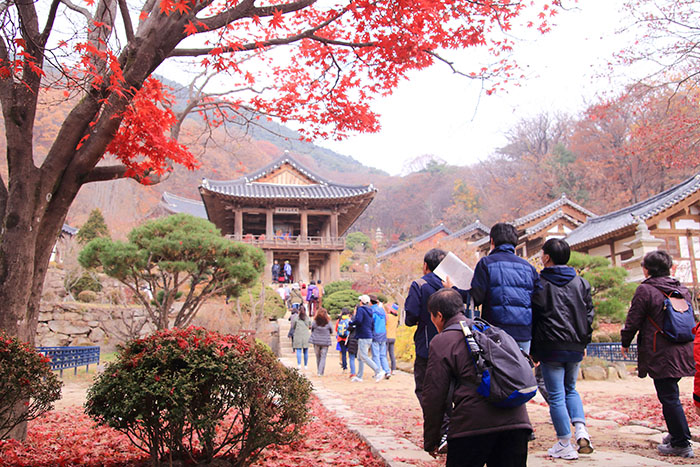
Many visitors visit Buseoksa Temple all year around.
By Korea.net Honorary Reporters Ma. Lilia Pedellume from the Philippines and Vince Grindle from the U.S.
Photos = Ma. Lilia Pedellume
Located on the side of Mt. Bonghwang in Yeongju, Gyeongsangbuk-do Province, Buseoksa was built by a renowned scholar-monk Uisang in 676, the 16th year of the reign of King Munmu of Silla.
The legend of Buseoksa
Monk Uisang was a disciple of Master Zhiyan Sanzang. He traveled to China to learn from him. While in China, there was a Chinese woman named Shanmiao who secretly fell in love with him.
When Monk Uisang completed his studies, he took a ship back to Silla. Shanmiao heard about his departure and hurried to the pier to see him. Unfortunately, the boat was not there anymore when she arrived. Upon finding out that the boat had left, she threw herself into the sea and turned into a dragon. As a dragon, she followed the ship and made sure that it reached Silla safely.
After arriving in Silla, Monk Uisang decided to build a temple. However, when the construction of the temple began, followers of different beliefs attempted to interfere with the construction. But Shanmiao, the dragon, would appear and make a huge rock float over them. The sight of the floating rock would scare them away and keep them from interfering with the construction of the temple. The rock became known as Buseok which was derived from the Sino-Korean characters (Hanja) bu (浮-부) which mean float and seok (石-석) which means stone. This also became the name of the temple, Buseoksa or “The Temple of the Floating Stone”. Up to this day, the said rock with the word 'Buseok' written in Hanja characters on its side, still exists and is located next to Buseoksa's Muryangsujeon Hall. But it does not float in the air as many might think it is. It is, instead, sitting on other rocks and does not touch the ground.
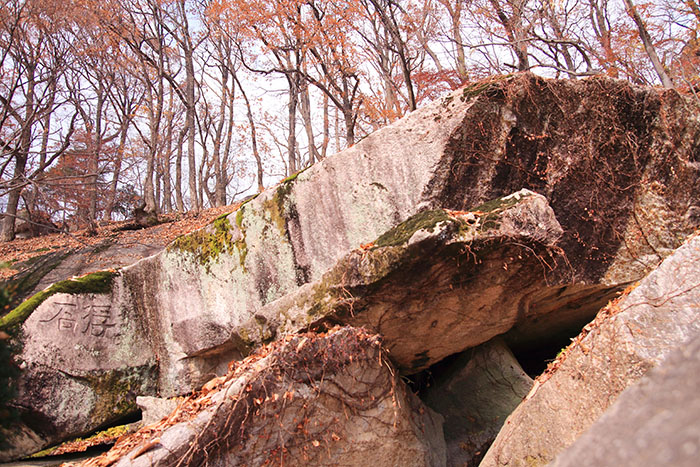
The 'floating stone' of Buseoksa is located behind Muryangsujeon Hall.
Beautiful landscape and cultural significance of Buseoksa
Muryangsujeon Hall is one of the South Korea's oldest standing wooden buildings. It is located higher up than the main temple shrine. In order to get to Muryangsujeon, you must climb nine steep concrete stairs. That might sound intimidating but they are not that difficult to climb. However, you can use some patience in dealing with other tourists trying to get their “shot of a lifetime” on that narrow staircase. You cannot blame them though.
Buseoksa is one of the temples in Korea with a beautiful landscape. The layered arrangement of the temple buildings is especially attractive. The fall foliage made the scenery even more beautiful.
Aside from the beautiful scenery, Buseoksa is also known for the cultural assets that it cherishes. It is home to five National Treasures of South Korea which include a stone lantern in front of Muryangsujeon Hall (No. 17), the Muryangsujeon Hall (No. 18), the Josadang Hall (No. 19), a seated clay statue of Amitabha Buddha (No. 45), and the wall painting in Josadang Hall (No. 46). Aside from the National Treasures, there are also eight treasures and two regional tangible assets located at Buseoksa.
Earlier this year, seven Korean Buddhist temples were added to the UNESCO World Heritage Sites list. The temples were listed under 'Sansa' or Korean mountain temples which are more than 1000 years old. One of those temples is Buseoksa.
Therefore Buseoksa is not just an ordinary temple. It is in fact a great temple that transcends through history. It is indeed a place worth visiting and knowing about.
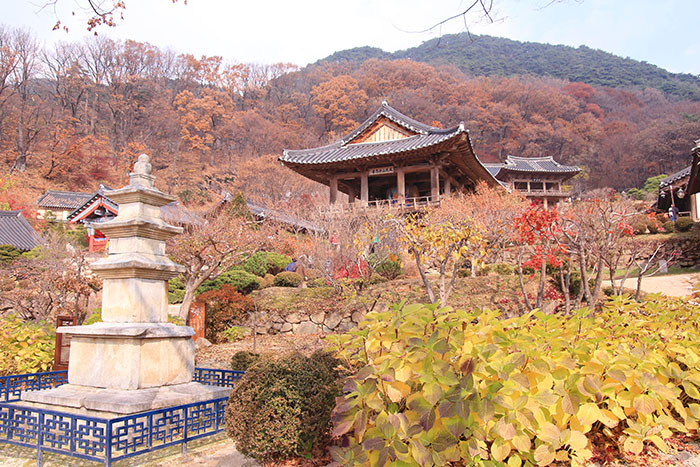
The scenery around Buseoksa Temple is beautiful.
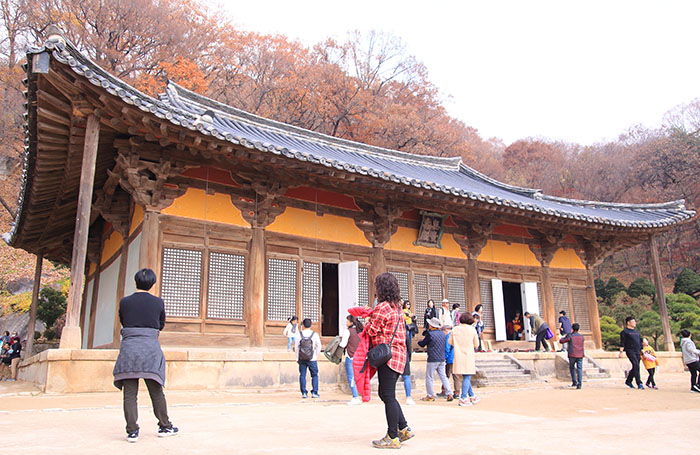
Muryangsujeon Hall is one of the most beautiful wooden building in Korea.
How to get There
First, you will need to take a train or bus to Yeongju. Once you are in Yeongju, you can either take public transportation or join the city tour.
City tour
The city tour bus will take you to the popular attractions in Yeongju along with Buseoksa. The city tour bus stop is located right in front of the train station and intercity bus terminal. It leaves Yeongju Train Station at 9:40 a.m. and Yeongju Intercity Bus Terminal at 10:00 a.m. Make sure to arrive 10 minutes before the scheduled departure. On-line reservation is available here. It costs 4,000 won per person. If you have a problem with on-line reservations, it is also possible to pay on-site. Paying on-site costs 6,000 won. The city tour ends at around 4:30 p.m.
Public transportation
From Yeongju Station, you will need to go to Yeongju Yeogaek (City Bus Terminal). From there, take bus No. 55 and get off at Buseoksa Temple (parking area). It takes about an hour and 15 minutes.
From Yeongju Bus Terminal, take bus No. 27 and get off at Buseoksa Temple. It takes about an hour and 30 minutes.
Tourist Information
Address: 345 Buseoksa-ro, Buseok-myeon, Yeongju-si, Gyeongsangbuk-do
Homepage (Korean only): http://www.pusoksa.org/
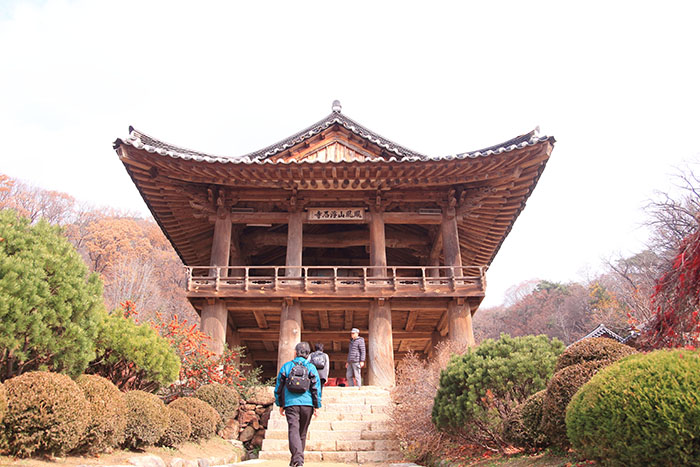
Beomjonggak Pavilion is known to be one of the biggest bell towers in Korea.
wisdom117@korea.kr
* This article is written by a Korea.net Honorary Reporter. Our group of Honorary Reporters are from all around the world, and they share with Korea.net their love and passion for all things Korean.